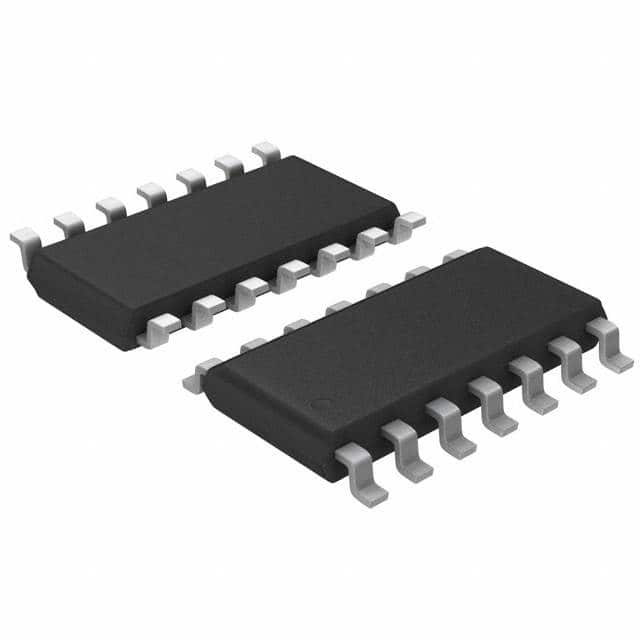Voir les spécifications pour les détails du produit.

Encyclopedia Entry: 74F164ASCX
Product Overview
Category
The 74F164ASCX belongs to the category of integrated circuits (ICs), specifically a shift register.
Use
This IC is commonly used in digital electronics for serial-to-parallel data conversion and parallel data storage applications.
Characteristics
- High-speed operation
- Low power consumption
- Compact size
- Wide operating voltage range
- Compatibility with various logic families
Package
The 74F164ASCX is available in a small outline integrated circuit (SOIC) package, which provides ease of handling and compatibility with standard PCB designs.
Essence
The essence of the 74F164ASCX lies in its ability to efficiently convert serial data into parallel format, enabling efficient data processing and storage in digital systems.
Packaging/Quantity
The 74F164ASCX is typically packaged in reels or tubes, containing a quantity of 250 or 1000 units per package.
Specifications
- Supply Voltage Range: 4.5V to 5.5V
- Operating Temperature Range: -40°C to +85°C
- Input Voltage High Level (VIH): 2.0V to VCC + 0.5V
- Input Voltage Low Level (VIL): -0.5V to 0.8V
- Output Voltage High Level (VOH): 2.4V (min)
- Output Voltage Low Level (VOL): 0.4V (max)
- Maximum Clock Frequency: 80 MHz
Detailed Pin Configuration
The 74F164ASCX has a total of 14 pins, each serving a specific function:
- Serial Data Input (DS)
- Clock Input (CP)
- Clear Input (CLR)
- Parallel Data Outputs (Q0-Q7)
- Ground (GND)
- Parallel Enable Input (PE)
- Power Supply Voltage (VCC)
Functional Features
- Serial-to-parallel data conversion
- Parallel data storage
- Clear function for resetting the register
- Parallel enable input for controlling data transfer
- High-speed operation for efficient data processing
- Wide operating voltage range for compatibility with various systems
Advantages and Disadvantages
Advantages
- High-speed operation allows for quick data processing.
- Low power consumption contributes to energy efficiency.
- Compact size enables space-saving integration into electronic systems.
- Compatibility with various logic families enhances versatility.
Disadvantages
- Limited number of parallel outputs (8 in this case).
- Requires external clock signal for proper operation.
- Sensitive to electrostatic discharge (ESD) and requires proper handling.
Working Principles
The 74F164ASCX operates based on the principle of shifting data bits through a series of flip-flops. The serial data input (DS) receives the incoming data, which is then shifted through the internal registers upon each rising edge of the clock input (CP). The parallel data outputs (Q0-Q7) store the shifted data in parallel format. The clear input (CLR) resets the register, while the parallel enable input (PE) controls the transfer of data from the serial input to the parallel outputs.
Detailed Application Field Plans
The 74F164ASCX finds applications in various digital systems, including but not limited to: - Data communication equipment - Computer peripherals - Industrial automation - Consumer electronics - Automotive electronics
Detailed and Complete Alternative Models
Some alternative models that offer similar functionality to the 74F164ASCX include: - 74HC164: A CMOS-based shift register with comparable specifications. - CD4015: A dual 4-bit static shift register with parallel outputs. - SN74LS164: A TTL-based shift register with similar pin configuration.
These alternative models can be considered based on specific project requirements and compatibility with existing systems.
In conclusion, the 74F164ASCX is a versatile integrated circuit that facilitates serial-to-parallel data conversion and parallel data storage. Its high-speed operation, low power consumption, and compact size make it suitable for various digital applications. However, it is important to consider its limitations and handle it with care to ensure proper functionality.
Énumérez 10 questions et réponses courantes liées à l'application de 74F164ASCX dans les solutions techniques
Sure! Here are 10 common questions and answers related to the application of 74F164ASCX in technical solutions:
Q: What is the 74F164ASCX? A: The 74F164ASCX is a 8-bit serial-in/parallel-out shift register integrated circuit (IC) commonly used in digital electronics.
Q: What is the purpose of a shift register? A: A shift register allows for the sequential shifting of data bits, either in or out, which is useful for tasks like data storage, data transfer, and parallel-to-serial or serial-to-parallel conversion.
Q: How many bits can the 74F164ASCX handle? A: The 74F164ASCX is an 8-bit shift register, meaning it can handle up to 8 bits of data.
Q: What is the maximum clock frequency supported by the 74F164ASCX? A: The 74F164ASCX typically supports clock frequencies up to 100 MHz, but this may vary depending on the specific datasheet and manufacturer.
Q: Can the 74F164ASCX be cascaded to handle more than 8 bits? A: Yes, multiple 74F164ASCX ICs can be cascaded together to handle larger numbers of bits. This allows for expansion of the shift register's capacity.
Q: What voltage levels does the 74F164ASCX operate at? A: The 74F164ASCX operates at standard TTL (Transistor-Transistor Logic) voltage levels, typically around 5V.
Q: Does the 74F164ASCX have any built-in output latches? A: No, the 74F164ASCX does not have built-in output latches. The outputs are directly driven by the internal shift register.
Q: Can the 74F164ASCX be used for both serial-to-parallel and parallel-to-serial conversion? A: Yes, the 74F164ASCX can be used for both serial-to-parallel and parallel-to-serial conversion depending on how it is configured.
Q: What are some common applications of the 74F164ASCX? A: The 74F164ASCX is commonly used in applications such as LED displays, data storage, data transfer between devices, and control systems.
Q: Are there any specific considerations when using the 74F164ASCX? A: Some considerations include proper power supply decoupling, ensuring correct clock timing, and understanding the specific pinout and functionality of the IC as described in its datasheet.
Please note that these answers are general and may vary depending on the specific implementation and requirements of your technical solution. Always refer to the datasheet and consult with experts for accurate information.

